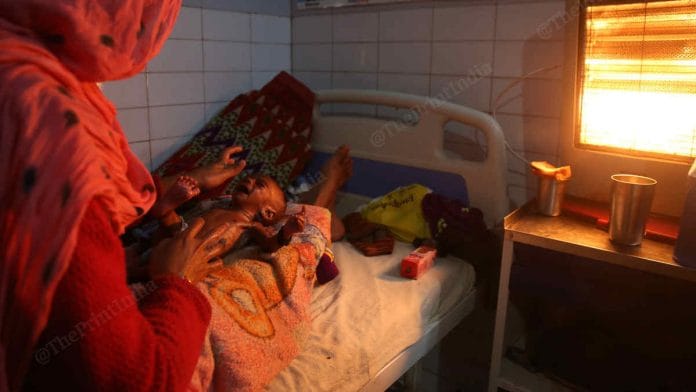New Delhi: On Sunday, Prime Minister Narendra Modi spoke about the Indian government’s nutritional programmes and how they have helped in reducing the problem of malnutrition. Yet, 47 years after the government instituted the Integrated Child Development Services (ICDS) — one of India’s oldest flagships for malnutrition alleviation — data from the latest round of the National Family Health Survey 5 shows that one in every three Indian children is still malnourished.
In his monthly ‘Mann Ki Baat’ radio broadcast, Modi spoke about India’s nutritional programmes and urged Indians to participate in the efforts to eradicate malnutrition in the country. The PM was addressing the programme just ahead of the ‘poshan maah’ (nutrition month) in September.
But data from the NFHS 5 — conducted between 2019 and 2021 and released in May this year — shows that 35.5 per cent of Indian children (Urban: 30.1 per cent, Rural: 37.3) under 5 are stunted — that is, their height is less than it should be for their age.
The data also shows that 32.1 per cent of children in the same age group (Urban: 27.3 per cent, Rural: 33.8 per cent) are underweight — that is, they weigh less than they should for their age — and that 19.3 per cent of children (Urban: 18.5 per cent, Rural: 19.5 per cent) are wasted, that is, they weigh less than they should for their height.
The latest NFHS Survey — a nationwide survey conducted by the Union Ministry for Health and Family Welfare — shows minor improvement over the previous one (NFHS 4) conducted between 2015 and 2016, when 38.4 per cent children were stunted, 21 per cent wasted, and 35.8 per cent underweight.
But the overall numbers remain deeply concerning. Experts claim India’s caught in a vicious circle where malnourished children grow up into malnourished mothers and give birth to malnourished infants.
While poverty is a major contributor to the problem, experts also point out structural issues in the governance model of India’s nutritional programmes that haven’t been addressed.
Dr. Arun Gupta, a former member of the Prime Minister’s Council on Nutrition, told ThePrint that India has a problem of “chronically undernourished babies”.
In 1975, the Indian government launched the ICDS with the explicit aim of improving the health and nutritional status of young children in the country. And yet, the problem remains despite some changes here and there “because ICDS has been an asphyxiated programme from the very beginning”, says Dr. Gupta.
Another problem, experts say, is that of jurisdiction: health is the remit of the Ministry of Health and Family Welfare while nutrition comes under the Ministry of Women and Child Development, creating governance issues.
Government officials, meanwhile, say that the central government’s ‘Poshan Abhiyan’ — the central government’s nutrition scheme — is a “multi-ministerial” one in which the health ministry also plays a part.
Also Read: Code red on malnutrition: Why half the kids in 3 poorest UP districts are stunted, many ‘wasted’
The element of poverty
Dr. Gupta says that an additional problem “is that there is a strong belief in the government that there is enough food and this is merely a problem of knowledge”.
Dr. Gupta was part of the PM’s Council on Nutrition instituted in 2008 under former prime minister Manmohan Singh. The Council was tasked with policy direction, review, and “effective coordination between ministries, which all will have a sectoral responsibility for the challenge of nutrition”.
“I believe lack of knowledge is only a part of the problem,” he told ThePrint. “Poverty plays a huge role too. Any programme to tackle malnutrition should have two arms — communication and food. Governments traditionally have focussed only on communication.”
That poverty and malnutrition are linked is a persistent refrain among experts. A study by the International Institute for Population Sciences published in the journal BMC Nutrition in 2020 found that malnutrition rates were higher in children who belonged to households that were not a part of the Public Distribution System.
“Undernutrition among children from poor households those excluded from PDS is highest, and it warrants inclusion in PDS. Improving the quality of food grains and widening food basket in PDS is recommended for reduction in [the] level of malnutrition in India,” researchers wrote in the study.
Delinking of health and nutrition
Experts also point out that having health and nutrition under two different ministries gives rise to unnecessary and unrealistic silos.
“This is a fundamental flaw in the governance of nutrition. You cannot possibly separate health and nutrition,” Dr. Gupta said.
A senior government official under the health ministry, however, said the government’s Poshan Abhiyan “is a multi-ministerial convergence mission of which health is very much a part”.
“Under the National Health Mission, we have issued ‘Operational Guidelines on Facility Based Management of Children with Severe Acute Malnutrition’. The 1080 Nutrition Rehabilitation Centres operate from a health facility and this is where acutely malnourished children are dealt with,” the official told ThePrint.
The guidelines are designed to help deal with children with severe acute malnutrition in a hospital setting.
Former bureaucrat Preeti Sudan says there are so many aspects of malnutrition that it could get lost in the health ministry, which already has “a lot on its plate”.
“In my view, it should be where it is now with the WCD ministry because it has that important community connection because of anganwadis (childcare centres to combat malnutrition and hunger that come under the ICDS), ” she told ThePrint. But, she says, “synergy of the ground-level workers is crucial”.
(Edited by Uttara Ramaswamy)
Also Read: Not just Global Hunger Index, India’s own govt data shows how worried we should be






